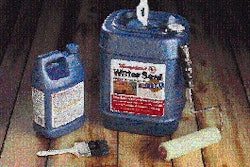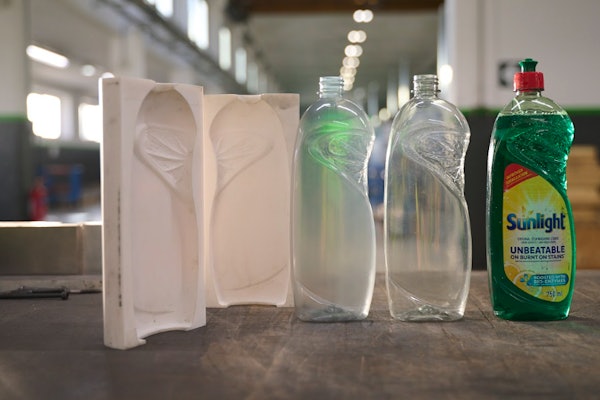There will be a brouhaha over brew labels early next year. That is when the Bureau of Alcohol Tobacco and Firearms (BATF) will put out a proposed rule on alcohol-content labeling of beer. Charles Bacon, a BATF official, says the BATF legal counsel has already rendered an opinion that the BATF (actually the agency prefers being known as the ATF) has the legal authority to require mandatory alcohol-content labeling on beer. Labeling has been optional since 1993. Having opened the door to mandatory labeling, though, the ATF has not made the decision yet to walk through it. The beer industry wants to slam the door closed before the ATF pushes any regulation through. Barbara Paterno, spokeswoman for Molson Breweries USA, Inc., Reston, VA, says her company opposes mandatory alcohol content labeling. She feels it would create problems for brewers in states with varying laws. For example, certain states require beer labeled at over 5% alcohol by volume to be called "ale" or "malt liquor." Some brewers think those terms limit the marketability of a beer. Other states require alcohol content to be designated in terms of percent by weight. The ATF and many states require it by volume. Still other states prohibit alcohol content on labels. It is not clear whether a recent Supreme Court victory for Coors Brewing Co., Golden, CO, on this issue means those states must rescind those laws. If those recalcitrant states hang tough, an ATF mandate on alcohol content would complicate distribution and probably increase labeling costs for brewers. Brewers divided Art DeCelle, general counsel for the Beer Institute, says an ATF proposal supporting mandatory labeling could split the industry. "We would work to prevent that proposal from being as divisive within the industry as it has been in the past." DeCelle explains it was difficult to get industry unanimity on behalf of Coors' suit against the ATF, first filed in 1987. The company filed a lawsuit in federal district court arguing that the ATF prohibition on putting alcohol content on a beer label was unconstitutional. Willis Lyford, a Coors spokesman, explains that the company was just going national with Coors at the time, and there was "scuttlebutt" on the East Coast that Coors was "watery." The company felt it could dispell that notion by putting the alcohol content on the can. After the district court agreed with Coors in 1992, the ATF published an interim rule in 1993 allowing brewers to put alcohol content on beer cans if they desired, and if there were no state prohibitions. Finally, in April 1995, the Supreme Court heard the case and agreed with Coors. In the aftermath of that decision the ATF took another look at its 1993 interim rule and decided to modify it based on the comments it received from various companies at the time. Not surprisingly, wineries and distilled spirits marketers, who already have to display alcohol content on their products, want brewers to belly up to that bar, too. Paul Thorpe, an attorney for E&J Gallo Winery, Modesto, CA, was one of those who wrote in to support mandatory alcohol content labeling in 1993. Standard serving statement So was William Roesing, vice president of public policy for Joseph E. Seagram & Sons, Inc., New York, N.Y. He wanted ATF to go even further. "In addition to making the alcohol content statement a mandatory requirement, Seagram believes that BATF should give serious consideration to requiring that all alcohol beverage labels contain a statement indicating the number of 'standard servings' of alcohol in the particular container. "Such information would significantly help consumers make informed decisions concerning their alcoholic beverage purchases and the amount of alcohol they might responsibly consume." He suggested that a 12-oz bottle of beer with 4.5% alcohol content by volume could be labeled "one standard serving." Seagram also thinks the ATF should come up with a new label symbol to draw consumers' attention to the new alcohol content information. Chris Tofalli, spokesman for Seagram, says the company's position has not changed. "We continue to think it is an important issue," he emphasizes. "The more people know the alcohol content of what they drink, the better off we will be." Consumer groups are also pushing for inclusion of a "standard serving" notation on the beer label. In his 1993 comments, Michael Jacobson, executive director of the Center for Science in the Public Interest, supported a declaration of alcohol content based on "unit service size" as a pro-health and an anti-drunk-driving measure. He cited a study done by Seagram & Sons in 1985 that showed only 59% of consumers surveyed after a Seagram's advertising campaign knew the relative strengths of different alcohol products. George Hacker, director of the alcohol policies project at the Center, says his group still strongly supports mandatory labeling. Coors moved fast Since the ATF interim rule in 1993, ice beers quickly sprouted alcohol content numbers on their labels. Mainstream beers such as Miller Lite Ice, Icehouse, and imports like Molson Ice all advertise their alcohol content demurely. Most domestic ice beers are brewed to about 5.5% alcohol by volume. Some imports are a bit higher, Molson at 5.6%, Fosters at 5.6% and Moosehead at 5.8%. Standard alcohol content for a beer is about 4.5%. Coors has barrelled into alcohol labeling. It introduced its ice beer entry in February 1994 calling it "Artic"-spelled differently than Arctic so Artic (5.3%) could be trademarked. Keystone Ice (5.3%) arrived in September 1994. Coors Extra Gold (5%) has been distributed nationally since 1988. The ATF has no ceiling on how high alcohol content can go. But there are two practical ceilings. First, beers have to be fermented to be called beers. Fermentation assumes a top alcohol content of perhaps 17%, according to the ATF's Bacon. Second, the gravity brewing process used by domestic brewers caps the alcohol content at between 7 and 9%, a level that is reduced further by processing with water. Molson's appears to be one of the few companies to put the alcohol content of its Ice beer on the six-pack paperboard carrier. The ATF's Bacon says the issue of secondary packaging and alcohol content labeling has not been addressed. The only way the ATF might get its nose out of joint over six-pack declarations is if they were part of a broader advertising campaign aimed at promoting a beer's high-octane image. Molson's Paterno says the company puts the alcohol number on the outer packaging of some Ice beers for the purposes of distribution. That allows the company to direct the product based on state requirements. Besides deciding whether to make alcohol content labeling mandatory, the ATF will have to establish whether alcohol content should be expressed by alcohol percent by volume, as in the interim rule, or by weight, as some states require. There will also be decisions on where numbers should be placed, and in what type size.
























